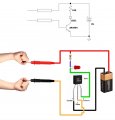My project purpose is that when you hold hands with a friend the passage of electric current through a circuit is enough to turn a buzzer or the ISD1820 voice recorder speaker. My first idea it to use the circuit below as reference, but I have no idea which transistor I should use to have current enough to turn for example a 3W-5V speaker. Could anyone give me hand?
Attachments
-
45.8 KB Views: 27









